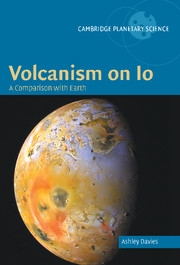Book contents
- Frontmatter
- Contents
- Preface
- List of Abbreviations
- Reproduction Permissions
- Introduction
- Section 1 Io, 1610 to 1995: Galileo to Galileo
- Section 2 Planetary volcanism: evolution and composition
- Section 3 Observing and modeling volcanic activity
- Section 4 Galileo at Io: the volcanic bestiary
- 9 The view from Galileo
- 10 The lava lake at Pele
- 11 Pillan and Tvashtar Paterae: lava fountains and flows
- 12 Prometheus and Amirani: effusive activity and insulated flows
- 13 Loki Patera: Io's powerhouse
- 14 Other volcanoes and eruptions
- Section 5 Volcanism on Io: the global view
- Section 6 Io after Galileo
- Appendix 1 Io hot-spot locations
- Appendix 2 Io maps
- References
- Index
- Plate Section
9 - The view from Galileo
Published online by Cambridge University Press: 05 October 2014
- Frontmatter
- Contents
- Preface
- List of Abbreviations
- Reproduction Permissions
- Introduction
- Section 1 Io, 1610 to 1995: Galileo to Galileo
- Section 2 Planetary volcanism: evolution and composition
- Section 3 Observing and modeling volcanic activity
- Section 4 Galileo at Io: the volcanic bestiary
- 9 The view from Galileo
- 10 The lava lake at Pele
- 11 Pillan and Tvashtar Paterae: lava fountains and flows
- 12 Prometheus and Amirani: effusive activity and insulated flows
- 13 Loki Patera: Io's powerhouse
- 14 Other volcanoes and eruptions
- Section 5 Volcanism on Io: the global view
- Section 6 Io after Galileo
- Appendix 1 Io hot-spot locations
- Appendix 2 Io maps
- References
- Index
- Plate Section
Summary
Galileo's arrival at Jupiter opened a new era of exploration of Io's volcanism. Plates 1 and 6 show Io as seen by Galileo. A global mosaic is shown in Plate 4, created using the best Galileo and Voyager image data (Becker and Geissler, 2005). Appendix 2 contains maps of Io with feature names.
After the disappointment of the loss of imaging during Jupiter orbit insertion, the first observations of Io by the Solid State Imaging experiment (SSI) and Near-Infrared Mapping Spectrometer (NIMS) were finally obtained in late June, 1996. The closest approach to Io during this encounter (Orbit G1) was 696 000 km, not as near as Voyager 1 got to Io (20 570 km) but closer than Voyager 2 (1 129 900 km). Eclipse observations by SSI showed high-temperature hot spots glowing in the darkness (McEwen et al., 1997). NIMS obtained spectra indicating the presence of silicate-temperature volcanism (Davies et al., 1997).
The first sunlit images of Io showed a surface that was, if anything, even more colorful than that seen by Voyager. Io's surface was dominated by black, red, yellow, white, and green hues, representing different mixtures of silicate and sulphur compounds. Over the next 3 years, Io was periodically observed by Galileo, mostly at long range (hundreds of thousands of kilometers) but culminating with a sequence of fly-bys as close as 182 km (Table 3.2).
- Type
- Chapter
- Information
- Volcanism on IoA Comparison with Earth, pp. 155 - 177Publisher: Cambridge University PressPrint publication year: 2007

